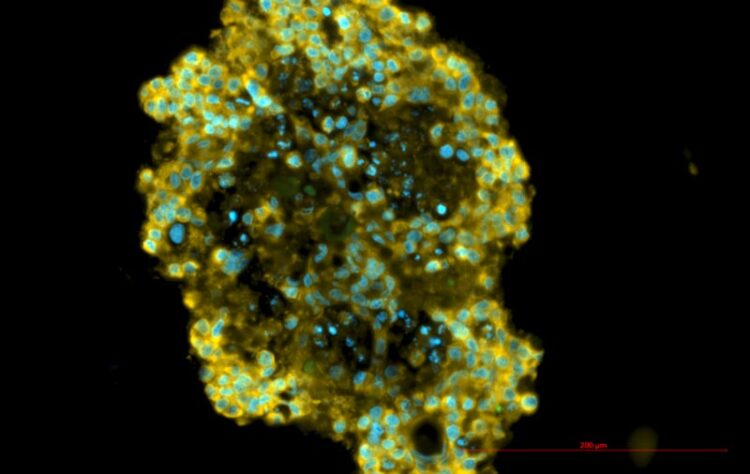Tumor avatars to fight colorectal cancer

The research team worked with organoids derived from untreated cancer tissue taken from patients.
Credit: UNIGE
A UNIGE team has developed a new approach to customize treatments by testing them on artificial tumors.
How to determine the most effective treatment for colon cancer? The response to chemotherapy varies greatly from one patient to another. A team from the UNIGE has developed a new method for testing different drugs, without going through the affected person’s body and without resorting to animal experiments. The researchers used organoids – miniature reproductions of organs and tissues – derived from patients and exposed to treatments. The results of these tests were then modelled. This approach opens the way to optimised and customised therapies against various forms of cancer and other diseases. It can be found in the Journal of Experimental & Clinical Cancer Research.
With more than 1.4 million people affected each year – 700,000 of them fatally – colorectal cancer is the third most diagnosed cancer in the world and the second most deadly, just after lung cancer. Its treatment is based primarily on a combination of chemotherapies called FOLFOXIRI. However, its effectiveness varies from patient to patient and its side effects are significant. It also leads to progressive drug resistance in most patients.
How can chemotherapy combinations be tested and optimised for each patient without causing numerous side effects? A UNIGE team led by Patrycja Nowak-Sliwinska, associate professor in the School of Pharmaceutical Sciences at the Faculty of Science of the UNIGE, and a member of the Translational Research Centre in Oncohaematology (CRTOH), has found the solution by using organoids. These three-dimensional cellular structures, created in the laboratory, reproduce the structure and functions of certain tissues and organs.
Almost like organs
‘‘These micro-tissues are not organs as such,’’ explains George M. Ramzy, a post-doctoral researcher in the School of Pharmaceutical Sciences at the Faculty of Science of the UNIGE and first author of the study. ‘‘They have some important physiological differences, such as not having vascular or nervous systems. However, they are very effective models for testing treatments.’’
The researchers started with cancer tissue taken from untreated patients at the Geneva University Hospitals (HUG). By cultivating stem cells from these tissues – which gradually divided and organised themselves into three-dimensional structures – the scientists were able to produce organoids, or tumoroids, from each patient’s tumour.
‘‘We then tested different drugs on these models, without knowing their genetic background,’’ explains Patrycja Nowak-Sliwinska. This individual background largely determines the effectiveness of the treatments. The researchers therefore started from scratch, basing their entire study on the observation of the cells’ response in real time.
Fast, effective and customised
These tumour avatars were exposed to a range of seven treatments currently in clinical use. Depending on the response of each patient organoid, the combination and dosages of these treatments were adapted. All results were mathematically modelled to predict the optimal efficacy and doses for each organoid, i.e. for each patient. These tests were carried out over two weeks. ‘‘This is a clinically relevant time frame: it is the time frame currently needed by the medical profession to choose a treatment after diagnosis,’’ says Patrycja Nowak-Sliwinska.
Thanks to a collaboration between the UNIGE research laboratory and the EPFL, the researchers were then able to determine the stage of each patient’s tumour and the main mutations involved in the progression of the disease. This information is relevant and essential to better understand the choice and mechanism of action of each drug combination. ‘‘Each patient is different and requires a specific treatment,’’ adds Patrycja Nowak-Sliwinska.
This innovative approach, without animal models, has just been patented. It offers personalised treatment for many forms of cancer, but also for other diseases such as cardiovascular or viral diseases. Trials are underway for renal cancer. For the research team, the next step will be to work on organoids from pre-treated colon cancer tumours, which therefore show signs of resistance. The aim will also be to shorten the duration of the optimisation process.
Journal: Journal of Experimental & Clinical Cancer Research
Method of Research: News article
Subject of Research: People
Article Title: Platform combining statistical modeling and patient-derived organoids to facilitate personalized treatment of colorectal carcinoma
Article Publication Date: 3-Apr-2023
All latest news from the category: Life Sciences and Chemistry
Articles and reports from the Life Sciences and chemistry area deal with applied and basic research into modern biology, chemistry and human medicine.
Valuable information can be found on a range of life sciences fields including bacteriology, biochemistry, bionics, bioinformatics, biophysics, biotechnology, genetics, geobotany, human biology, marine biology, microbiology, molecular biology, cellular biology, zoology, bioinorganic chemistry, microchemistry and environmental chemistry.
Newest articles

Breaking boundaries: Researchers isolate quantum coherence in classical light systems
LSU quantum researchers uncover hidden quantum behaviors within classical light, which could make quantum technologies robust. Understanding the boundary between classical and quantum physics has long been a central question…

MRI-first strategy for prostate cancer detection proves to be safe
Active monitoring is a sufficiently safe option when prostate MRI findings are negative. There are several strategies for the early detection of prostate cancer. The first step is often a…

Microelectronics Science Research Centers to lead charge on next-generation designs and prototypes
Pacific Northwest National Laboratory to contribute leadership to national effort in microelectronics design and development. Microelectronics run the modern world. Staying ahead of the development curve requires an investment that…



